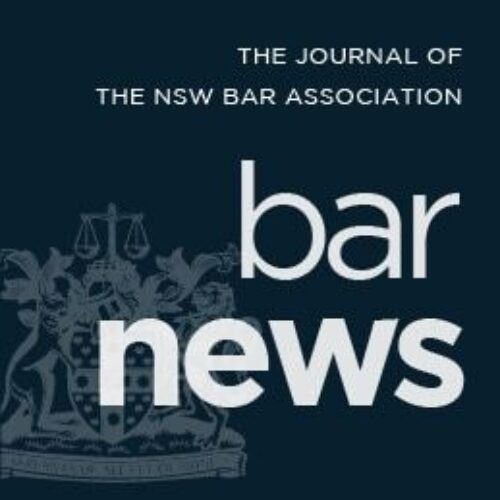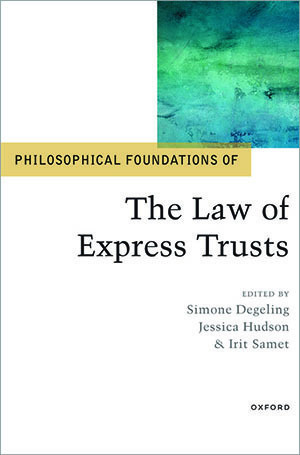- Winter 2024
- Philosophical Foundations of the Law of Express Trusts By Simone Degeling, Jessica Hudson & Irit Samet (eds) (Oxford University Press, 2023)
Philosophical Foundations of the Law of Express Trusts By Simone Degeling, Jessica Hudson & Irit Samet (eds) (Oxford University Press, 2023)


This edited collection is a welcome addition to the Oxford University Press Philosophical Foundations series in what the editors describe as an ‘under-theorised’ area of the law. The suggestion of theory ought not scare off the practising profession. The work contains many interesting chapters that attempt to bridge the divide between doctrine and theory, and the philosophical interplay between property and trusts as bodies of rules is a thread that runs through many of the chapters and helps to draw this diverse collection together.
Ben Macfarlane’s chapter ‘Trust, Property, and Rights’ explores the extent to which concepts of ‘property’ assist in understanding trusts. Sceptical about the utility of viewing trust law through the lens of ‘property’, Macfarlane refers to the ‘package of legal relations that constitute the rights held on trust’ in order to explain both the nature of the trustee’s obligations and the beneficiary’s interest. The consequences of Macfarlane’s argument are explained by reference to concrete examples like the trustee’s ‘right of exoneration’, described in Carter Holt Harvey Woodproducts Australia Pty Ltd v Commonwealth (2019) 268 CLR 524 [31] as ‘a power to use trust funds to discharge debts that were properly incurred by the trustee’. For Macfarlane, ‘it is more pertinent to see the right of exoneration as a liberty’ that reflects a limit on the scope of the duties owed by the trustee.
David Foster’s chapter ‘Historical Conceptions of the Express Trust, c 1600–1700’ reveals a similar scepticism about the use of ‘property’ to explain trust relationships. The deeply historical account casts the debates about a beneficiary’s interest as being either in rem or in personam as an incomplete relic of Austinian analytical jurisprudence. Foster explains the foundations of trust stemming from the 16th-century ‘personal’ conception of placing trust in a particular individual and, therefore, attaching to the trustee’s conscience. For Forster, more modern property-based accounts are a distraction. Similarly to Macfarlane, Foster examines concepts, sometimes used unthinkingly, to reveal what they tell us about the content of trust law.
Hudson and Mitchell’s chapter ‘Justificanda’ opens the collection with the ambitious project of justifying the law of trusts but with a methodology that is deeply devoted to doctrine. For Hudson and Mitchell, the trust is an institution that affords ‘parties the power to redefine the trustee’s authority as titleholder’. The authors acknowledge that account of ‘what is a trust’ may assist in future justificatory projects, which they posit may be by reference to autonomy or law and economics. But importantly, and in echoes of Macfarlane’s chapter, a central conclusion is that trust law cannot be collapsed into property law. Rather, trust law explains the way people use, or are constrained in the use of, other sets of legal norms, including the title-conferring rules of property law.
Agreeing with the distinct place for trust law in any account of private law, Matthew Harding’s chapter ‘A Fresh Look at Purpose Trusts’ argues that purpose trusts represent a distinctive autonomy-enhancing legal form that enables settlors to organise their affairs in a way that is not fully achievable using other legal forms. But in a challenge to orthodoxy, Harding questions the basis for the law’s exclusive recognition of purpose trusts in the case of public or charitable trusts but not for private purposes. Harding questions accounts of trusts as jural relationships between trustee and beneficiaries, given that charitable trusts with no such relationship ‘have been regarded as trusts for hundreds of years’.
One of the more overtly philosophical of the chapters is Hanoch Dagan and Irit Samet’s chapter ‘Express Trust: The Dark Horse of the Liberal Property Regime’. It serves as an (acknowledged) methodological counterpoint to Hudson and Mitchell and seeks to justify the law of trusts as autonomy enhancing. The justification is set against concerns, for example, that the use of trusts to put property beyond the reach of creditors cannot be justified as autonomy enhancing and undermines distributive and relational justice. Theirs is a jurisprudential account, with the consequences for the precise content of trust law – ie the answer to contentious questions of doctrine – left for others.
Paul Miller’s chapter cuts to the ‘philosophical foundations’ of what is (often) an assumed element of testamentary trusts – the freedom of disposition. Miller’s chapters asks, how can we justify (morally) freedom of testamentary disposition? Miller adopts an overtly Aristotelian/Finnisian methodology by proposing a central or ‘focal’ meaning of testamentary freedom as a freedom to make legally effective gifts of property that take effect upon death animated by a bona fide donative intention. Through that focal account, Miller posits that testamentary dispositions are best viewed through the morally justifiable practice of gift giving and gift relationships, so that testamentary freedom is justified because it enables morally well-motivated choices that provide opportunity for the practice of virtue (eg by exercising the freedom in favour of those to whom one has a moral duty to act, like dependents). Miller’s method recognises that certain dispositions may be legally valid but must be criticised as morally deviant from the central case, as not instantiating virtue or social goods – for example, spiteful disinheritance. Miller recognises that the justification offered in his chapter is a necessary first premise for later resolution of thorny policy questions like legislative reforms to the scope of freedom, or the appropriateness of inheritance tax.
Sinéad Agnew’s chapter ‘The Settlor’s Conscience’ demonstrates a keen interest in explaining doctrine. Agnew explores the extent to which the focus upon the settlor’s conscience explains developments in the cases. Of interest is Agnew’s engagement with the Court of Appeal’s decision in Pennington v Waine (No 1)[1] and the extent to which it could be seen as relaxing what is described as the rule in Re Rose[2] (a requirement for a donor to have done all within her power to divest herself of and transfer property before equity would assist a volunteer). The author observes a willingness in the cases to offer protection to putative donees and suggests that a ‘conscience-based’ approach anchored in detrimental reliance may provide some guidance for the development of doctrine. The chapter raises, but does not resolve, the need to set some doctrinal parameters to any such approach.
Simone Degeling’s chapter ‘Administrators as Trustees of Australian Class Action Settlements’ will also be of interest to practitioners. Examining the essential role that trusts play in settlement distribution schemes sanctioned by the court, Degeling’s detailed chapter concludes that the institution of the trust ensures the settlement funds reach group members because the trust ‘permits a particular structure of court supervised delegated decision-making and distribution’ – the point being that trusts provide the elaborate legal architecture in which group members are afforded standing to enforce the terms of the settlement scheme and administrators are subject to the supervisory jurisdiction of the court, and if necessary, the protections afforded from an ability to seek judicial advice.
Simon Douglas’ chapter offers a novel account of trusts as ‘weak estates’ by analogy with personhood, which is of particular interest in the peculiar context of English law and the numerous instances in which statutory developments have afforded trusts a degree of ‘personhood’. Ann Mumford’s chapter asks pertinent questions about the extent to which trust law can justify the evasion of tax in other jurisdictions.
True to its name, the work contains the foundational justifications and explanations of elements of trusts law that are worthwhile contributions to scholarship in their own right. But any reader will be interested to see what a number of the authors eventually construct on these foundations in later works that will have to grapple with the implications of their writings for contentious points of doctrine.
ENDNOTES
[1] (2002)1 WLR 2075.
[2] [1949] Ch 78.
